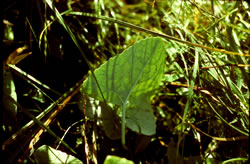Plant of the Week
 Petasites sagittatus range map. USDA PLANTS Database.
Petasites sagittatus range map. USDA PLANTS Database.
 Close-up of the inflorescence of Petasites frigidus var. sagittatus from Laramie Range, Albany County, Wyoming. Photo by Walter Fertig.
Close-up of the inflorescence of Petasites frigidus var. sagittatus from Laramie Range, Albany County, Wyoming. Photo by Walter Fertig.
 Woolly underside of the leaf of Petasites frigidus var. sagittatus with its characteristic colt’s foot shape, from Laramie Range, Albany County, Wyoming. Photo by Walter Fertig.
Woolly underside of the leaf of Petasites frigidus var. sagittatus with its characteristic colt’s foot shape, from Laramie Range, Albany County, Wyoming. Photo by Walter Fertig.
 Petasites frigidus var. sagittatus in habit. Photo by Walter Fertig.
Petasites frigidus var. sagittatus in habit. Photo by Walter Fertig.
Sweet coltsfoot (Petasites sagittatus)
By Walter Fertig
Sweet coltsfoot (Petasites frigidus) earns its common name from the sweet scent of its flowers and the large, basal leaves. Coltsfoot begins flowering as early as February in cold, swampy wetlands across Alaska and northern Canada to Newfoundland and south to California, Colorado, South Dakota, Wisconsin, and New York. Often coltsfoot is the first wetland species to begin flowering. The plant’s cluster of white to pinkish-purple flower heads is borne at the tip of a fleshy stem covered by clasping, scale-like leaves. The larger basal leaves (the ones that look like horse hooves) emerge later in the spring, often after the flower heads have been replaced by silvery-white seed heads. These leaves arise a short distance from the flowering stalk at the end of an underground rhizome.
At one time taxonomists recognized four species of Petasites in North America, each differing primarily in the shape of the basal leaves. Its arrowhead-shaped leaves distinguished Petasites sagittatus, while P. palmatus had leaves deeply cleft into palmate leaflets, and P. frigidus and P. vitifolius were more coarsely toothed. All of these forms intergrade, leading researchers to lump the North American taxa into a single species, P. frigidus, with four varieties. Worldwide, 15-18 species of Petasites are recognized, with the other species all occurring in Europe and northern Asia.
Petasites is considered closely related to the European species Tussilago farfara, which is also often called coltsfoot. Both genera are members of the sunflower family (Asteraceae) and have broad leaves that appear after the flowers emerge in early spring. Both groups have also been used medicinally to treat coughs and congestion. The rhizomes, petioles, and young flowering stalks of some species have been reported to be edible, though pyrrolizidine alkaloids in all parts of Petasites can cause cumulative liver damage. Burned to ash, the foliage of Petasites has been reported as a natural salt substitute.

